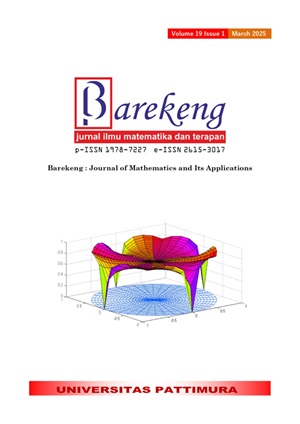STOCK PRICE PREDICTION AND SIMULATION USING GEOMETRIC BROWNIAN MOTION-KALMAN FILTER: A COMPARISON BETWEEN KALMAN FILTER ALGORITHMS
Abstract
Stocks have high-profit potential but also have high risk. Many people have ways to forecast stock prices. The Geometric Brownian Motion (GBM) method forecasts stock prices. The data used in this study are closing stock price data from July 1, 2021 to August 31, 2021 taken from Yahoo! Finance. The stocks used in this research are Bank Rakyat Indonesia (BBRI), Indofood Sukses Makmur (INDF), and Telkom Indonesia (TLKM). A strategy is carried out to improve prediction accuracy by utilising the Kalman Filter (KF). This research will compare the mean absolute percentage error (MAPE) value between GBM-KF, which was manually computed and computed using the Python library. As an example of this research, for BBRI stock, the high GBM MAPE value of 9.02% can be reduced to 3.52% with manually computed GBM-KF and 3.68% with Python library computed GBM-KF. Similarly, INDF and TLKM stocks are showing a significant reduction in MAPE values to deficient levels in some cases. The GBM-KF method employing manual computing may enhance the overall precision of stock price forecasting. Future research may enhance this study by using the GBM-KF model on alternative financial instruments, integrating supplementary market data, or evaluating its efficacy under extreme market conditions.
Downloads
References
R. Gesta Erawati Supriyanto, E. Andayani, and A. Farrabanie Al Arsy, “Pengaruh Preferensi Resiko, Literasi Ekonomi, Pengetahuan Galeri Investasi Terhadap Minat Investasi Mahasiswa Fakultas Ekonomika Dan Bisnis,” Jurnal Riset Pendidikan Ekonomi, vol. 4, no. 1, pp. 1–7, 2019, [Online]. Available: http://ejournal.unikama.ac.id
N. Suprasta and N. MN, “Faktor-Faktor Yang Mempengaruhi Pengambilan Keputusan Investasi Saham,” Jurnal Ekonomi, vol. 25, no. 2, pp. 251–269, 2020, Accessed: Jan. 23, 2024. [Online]. Available: http://www.ecojoin.org/index.php/EJE/article/view/669/649
A. Humayrah and D. P. Sari, “Analisis Risiko Investasi Saham Tunggal Syariah dengan Value at Risk (VaR) Menggunakan Simulasi Monte Carlo,” Journal of Mathematics UNP, vol. 8, no. 1, pp. 32–35, Mar. 2023, doi: 10.24036/UNPJOMATH.V8I1.13375.
Y. Gao, R. Wang, and E. Zhou, “Stock Prediction Based on Optimised LSTM and GRU Models,” Sci Program, vol. 2021, 2021, doi: 10.1155/2021/4055281.
M. Azizah, M. I. Irawan, and E. R. M. Putri, “Comparison of Stock Price Prediction using Geometric Brownian Motion and Multilayer Perceptron,” in AIP Conference Proceedings, American Institute of Physics Inc., Jun. 2020. doi: 10.1063/5.0008066.
R. Kumar Si and B. Bishi, “Forecasting Short Term Return Distribution of S&P BSE Stock Index Using Geometric Brownian Motion: An Evidence from Bombay Stock Exchange,” 2020. [Online]. Available: http://www.ripublication.com
W. Farida Agustini, I. R. Affianti, and E. R. M. Putri, “Stock price prediction using geometric Brownian motion,” J Phys Conf Ser, vol. 974, no. 1, Mar. 2018, doi: 10.1088/1742-6596/974/1/012047.
K. Reddy and V. Clinton, “Simulating Stock Prices Using Geometric Brownian Motion: Evidence from Australian Companies,” Australasian Accounting, Business and Finance Journal, vol. 10, no. 3, pp. 23–47, Sep. 2016, doi: 10.14453/aabfj.v10i3.3.
M. M. Jaffar, S. Nazifah, Z. Abidin, and M. Mohd Jaffar, “Forecasting Share Prices of Small Size Companies in Bursa Malaysia Using Geometric Brownian Motion,” Applied Mathematics and Information Science, vol. 8, no. 1, pp. 107–112, Jan. 2014, doi: https://doi.org/10.12785/amis/080112.
D. A. I. Maruddani, T. Trimono, and M. Mas’ad, “Implementation of Stochastic Model for Risk Assessment on Indonesian Stock Exchange,” MEDIA STATISTIKA, vol. 15, no. 2, pp. 151–162, Apr. 2023, doi: 10.14710/MEDSTAT.15.2.151-162.
S. Gultekin and J. Paisley, “A Collaborative Kalman Filter for Time-Evolving Dyadic Processes,” in 2014 IEEE International Conference on Data Mining, Shenzhen: IEEE, Dec. 2014, pp. 140–149. doi: 10.1109/ICDM.2014.61.
Fauziyah and E. Purnaningrum, “Optimization of Stock Portfolios Using Goal Programming Based on the Kalman-Filter Method,” Jurnal Matematika MANTIK, vol. 7, no. 1, pp. 20–30, May 2021, doi: 10.15642/mantik.2021.7.1.20-30.
W. H. Syaifudin, E. R. M. Putri, W. H. Syaifudin, and E. R. M. Putri, “The application of model predictive control on stock portfolio optimisation with prediction based on Geometric Brownian Motion-Kalman Filter,” Journal of Industrial and Management Optimization, vol. 18, no. 5, pp. 3433–3443, 2022, doi: 10.3934/JIMO.2021119.
T. N. Mustika, “Prediksi Harga Saham dengan Geometric Brownian Motion dan ARIMA - Termodifikasi Kalman Filter,” Sepuluh Nopember Institute of Technology, Surabaya, 2019. Accessed: Mar. 18, 2024. [Online]. Available: https://repository.its.ac.id/69162/1/06111750012010-Master_Thesis.pdf
V. Maulidya, E. Apriliani, and E. R. M. Putri, “Prediksi Harga Saham Menggunakan Geometric Brownian Motion Termodifikasi Kalman Filter dengan Konstrain,” Indonesian Journal of Applied Mathematics, vol. 1, no. 1, pp. 6–18, 2020, [Online]. Available: https://journal.itera.ac.id/index.php/indojam/
J. Lidén, “Stock Price Predictions using a Geometric Brownian Motion,” Uppsala, May 2018.
J. Hull, Options, Futures, and Other Derivatives, 11th ed. Pearson, 2021. Accessed: Jan. 23, 2024. [Online]. Available: https://www.amazon.com/Options-Futures-Other-Derivatives-Global-dp-1292410655/dp/1292410655/ref=dp_ob_title_bk
M. Khodarahmi and V. Maihami, “A Review on Kalman Filter Models,” Archives of Computational Methods in Engineering, vol. 30, no. 1, pp. 727–747, Jan. 2023, doi: 10.1007/S11831-022-09815-7/METRICS.
A. Roberts, “Mean Absolute Percentage Error (MAPE): What You Need To Know,” Machine Learning Course. Accessed: Apr. 19, 2024. [Online]. Available: https://arize.com/blog-course/mean-absolute-percentage-error-mape-what-you-need-to-know/
Copyright (c) 2025 Dimas Avian Maulana, A'yunin Sofro, Danang Ariyanto, Riska Wahyu Romadhonia, Affiati Oktaviarina, Mohammad Dian Purnama

This work is licensed under a Creative Commons Attribution-ShareAlike 4.0 International License.
Authors who publish with this Journal agree to the following terms:
- Author retain copyright and grant the journal right of first publication with the work simultaneously licensed under a creative commons attribution license that allow others to share the work within an acknowledgement of the work’s authorship and initial publication of this journal.
- Authors are able to enter into separate, additional contractual arrangement for the non-exclusive distribution of the journal’s published version of the work (e.g. acknowledgement of its initial publication in this journal).
- Authors are permitted and encouraged to post their work online (e.g. in institutional repositories or on their websites) prior to and during the submission process, as it can lead to productive exchanges, as well as earlier and greater citation of published works.






1.gif)



